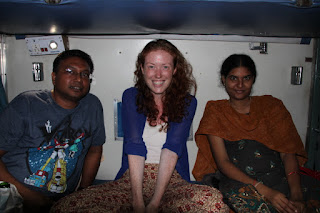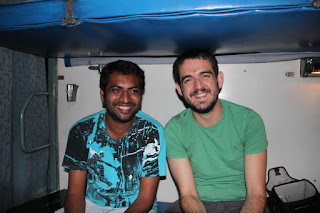We arrived in Hampi at around 6:30AM. The Sleeper Bus had been as about as comfortable as expected so we were rather tired and somewhat rough. Nevertheless we checked in to a hotel and put our heads down for a few hours.
Hampi is a popular stop on the tourist trail, we were located within Hampi Bazaar, a village packed with budget hotels, shops and restaurants. The Bazaar is one of the main entry points to the Hampi ruins and so we were ideally situated in a central location.
Hampi was once the capital of one of the largest Hindu empires in Indian history. This was until it was invaded, destroyed and left for dead by Sultanates in 1565. Consequently, Hampie now consists of a large network of ruins divided into two main areas: Hampi Bazaar and The Royal Center.

Our first venture into Hampi was to see Lakshmi, the Virupaksha Temple elephant who receives a bath in the River Ghats every morning. Seeing her was amazing. She was breathtakingly beautiful and surprisingly
graceful given her size. Lakshmi is led by several keepers down to the river and crowds gather to admire the towns treasure. Whats interesting is that the Ghats is also the place where towns people bathe and wash their clothes. So you have Men, Women and Children splashing around, whilst a few meters away Lakshmi, the elephant, is having her daily soak. There was something very natural, yet completely alien about the whole scene.
Sometime after we had seen Lakshmi we went to visit her home at The Virupaksha Temple. This is one of the oldest buildings in Hampi, and its main Shrine is dedicated to Virupaksha, a form of Shiva. It was here that Shiva, in the form of the Destroyer, was said to have appeared to the invading Sultanates causing them to flee the City which they had so barbarically destroyed.

By the time we arrived Lakshmi was already home and we were again struck by her beauty. We were able to stroke Lakshmi and for a few Rupees I was blessed by her. I have never been so in awe of a creature before, her rough skin, gentle eyes, huge feet and adorable trunk were completely hypnotic. However, joy and wonder soon turned to sadness as the realization of Lakshmi's isolation crept in. She does not have a family, she will never know the love of a mate, nor will she carry offspring. The combined with such a small enclosure for such a large animal felt unfair.These people seem to hold the elephant in some regard and yet she is chained up and performs what could be likened to a circus trick for Rupees. Is it selfish, lack of understanding and care or simply a matter of cultural concern? Either way, we left Lakshmi with a heavy heart.
We next went on a guided tour of the Temple. This was with a local who only asked for a donation for his service (we gave him 200 Rupees). The tour was beneficial, we learnt about some of the Temples history, saw some of its quirks and gained an understanding of its place in Hampis story.
After the tour, and on the recommendation of our guide, we ventured up Matanga Hill, a colossal and rocky mountain-like structure from which you can see the whole of Hampi. The climb was exhausting, but as the saying goes, the destination was worth the ride - the view was absolutely stunning. We gazed out for quite some time (partly to regain our breath) at the magnificent labyrinth of ,and the whole sight really put Hampi into perspective for us.
The next day we had an early start to avoid mid-day heat. We moved from our hotel to a much more comfortable guesthouse (bartering in such places will get you a good deal) and then went to the corner tea stand for some Chai. I don't believe I have mentioned 'Chai Lady' yet - She was lovely. A very smiley lady who made the best tea we have ever tasted. 'Chai Lady' (who in our minds, later developed into a Superhero with the power of Chai) had an authority about her, the Auto-rickshaw men seemed to love her and we got the impression she could source most things in Hampi. On this particular morning she sourced us two bicycles for the bargain price of 150 Rupees - Excellent.

I didn't know that bikes could come without gears, but these ones did and by Shiva were they heavy. Nonetheless, they proved to be the perfect way to get around Hampi (both a pleasant and cost effective alternative to the Auto-rickshaw tours on offer) and that morning we visited The Royal Centre. Sights here included The Queens Bath, The Lotus Mahal and some old Elephant Stables, all of which we thoroughly enjoyed.
That afternoon, once the sun had cooled, we then made our way to the Vittala Temple which is herald as the highlight of Hampi. It did not disappoint. The series of buildings which make up the Temple are still in good condition and the sheer size of the complex is bewildering.
It is thought that work on the Temple began in 1509. Interestingly, it was never finished (presumably due to Hampis invasion) and consequently the Temple was never consecrated. Whats more, this seemed to be reflected in the way the Temple was treated - people lounged, children climbed and noise polluted the air in ways unheard at other sites.
Perhaps, unlike other Temples, Vittala is only noted for its architectural qualities rather than its religious significance. Either way we found this a little unfortunate. The Temple reminded me of being all dressed up with nowhere to go. I saw Vittala as an aged Goddess who was no longer desired or a gifted starlet who never got her time to shine. Thankfully the crowds soon departed and we were able to enjoy the quiet serenity of the Temple. A sense of abandonment filled the air in a way which felt quite befitting to Vittalas story.
The outer pillars of the central structure at Vittala are known for being musical - they form notes when tapped accordingly. Authorities have places them out of tourists reach and therefore their music is no longer heard by the masses. Lucky for us, we were approached by a Guard who offered to discreetly play the pillars in exchange for a tip. At the time we were too excited to know just how naughty this was, but the Guard quickly becoming concerned about various cameras dotted about the structure soon had us realise.
The sound of the pillars somewhat resembled a Xylophone, with each one designed to produce a slightly different noise. Quite a marvel really, such a creative and clever aspect of the buildings infrastructure.
But again, as with Lakshmi the elephant, once the initial intrigue of the pillars had subsided, there was a slight regret. The Guard had been employed to protect and preserve the delicate structure, but here he was exploiting it for personal gain. Would this have been the case if the Temple had been consecrated as planned or was this act of ignorance another sign that Vittala is not respected in the way she was intended?
All in all, I have just about summed up our time in Hampi. Beyond what has been reported we ate a delicious banana curry, refined our bartering skills, drank copious amounts of 7UP (Hampi is a religious site and therefore no alcohol is allowed) and generally just pottered about.
We loved Hampi, we had an excellent time and feel like we experienced a truly magical place steeped in Indian history.


































